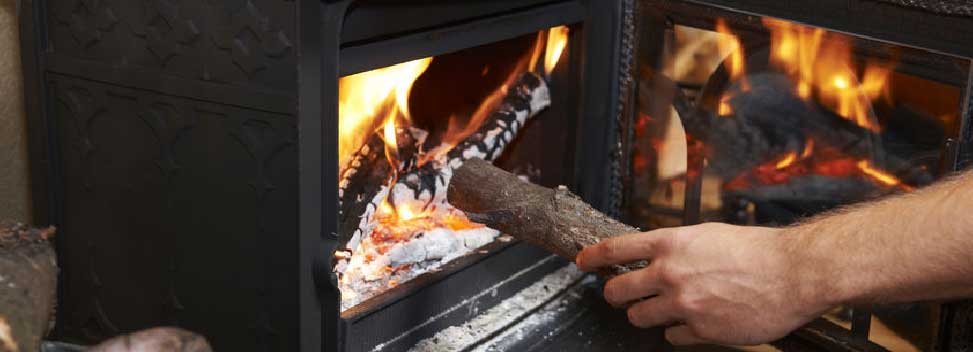A Guide to log burning stoves & chimneys in holiday homes
Written by Nick Grant
|
Published on 10th October 2016
|
Last Updated on 27th February 2024
|
Read time: 5 minutes

Log burning stoves & chimneys in holiday homes
Wood burning stoves can make a great feature in a holiday home or cottage. They appeal to holiday let guests and they can be an efficient heat source that can cut energy bill by a quarter*. However, compared to other heat sources, they come with additional risks and maintenance requirements particularly if your holiday home is listed or thatched. Holiday home insurance can cover you for damage caused by log burning heaters and chimneys but in order to stay protected, often certain endorsements apply to the policy. To help keep you, guests and your home safe, take a look at our useful list of tips and advice.
Log burning stoves & chimneys in holiday homes
Log burning stoves are designed to burn without leaking smoke, including when the doors are open. So even if there is a problem with the seal, it should still draw air in as opposed to pushing smoke out which is typically the result of a downdraft.
When smoke is puffed back into the room it can be full of particles and toxins that can be damaging to health. One way to fix this is to increase the height of the chimney and fit an anti-downdraft cowl.
When using a wood burning stove, the chimney attached should be masonry or UL listed and lined with a non-combustible material. This can often be a condition on holiday home insurance policies.
Reducing the risks: Safety measures to protect you and guests in your holiday home
Top Tip!
Your stove must never be connected to a flue which vents an oil burner, as the unburned vapours from the oil could blow back into the stove and seep into the room where the stove is located.
To reduce the risk of starting a fire in your holiday home, the wood burning stove should be fitted to a fire resistant base.
The stove should also be kept a certain distance away from any combustible materials. Fires often happen because wood is stored too close to the stove. It only takes one little spark to start a blaze.
Ventilation systems can also be problematic with 90% of all stove related fires originating in the venting system.
To avoid the chance of a stove related fire, the venting system should be kept as short as possible, have no more than 2 right angles and the crimped ends of the pipe should be facing downwards towards the stove.
The chimney which the stovepipe leads to should be masonry lined or ideally be a UL listed, factory built chimney. If the stove pipe has to pass through an exterior wall, there should be at least 18” of clearance from any nearby combustibles.
Carbon Monoxide (CO)
Carbon monoxide is odourless, tasteless and invisible, which is why it can overwhelm people so quickly. Breathing high levels of CO over a short period, or low levels over a long period, are just as dangerous as each other.
Top Tip!
Carbon monoxide alarms should not be placed over or next to a fireplace or a flame producing appliance as this will affect the accuracy of the results.
This deadly gas kills over 40 people in Wales and England annually, with another 4,000 treated in hospital for poisoning mostly caused by faulty fossil fuel and wood burning appliances. It is therefore the most dangerous by-product of a log burning stove.
Current UK legislation requires any home with a wood burning or multi-fuel stove to have a CO alarm. To protect you and any guests staying in your holiday home, you should fit carbon monoxide detectors on each floor of the property and check the alarm regularly to ensure that it is functioning correctly.
Holiday home insurance – checks you can take to protect your property and maintain your stove
Top Tip!
In order for insurance to remain valid, for many insurers it’s a requirement that the chimney is swept on an annual basis with appropriate certification or receipt of the work.
To keep your log burning stove in good working order, it’s important that the correct fuel like hard woods such as maple, beech, ash, hickory or oak is used. When letting the property out, clear instructions should be given to ensure that your guests are using the stove correctly.
There are numerous checks you can perform to help keep your stove in good working order and to keep your holiday cottage safe.
- Check for black, sooty marks, on the wall around stoves, boilers, fires and on the clay radiator bars of gas fires
- Any smoke accumulating in rooms
- A blue flame on a gas appliance is burning yellow could indicate a problem which should be investigated by an engineer
- Empty and check the ash can every day
- Clean out the flue ways on the back of the boiler once a week
Holiday homeowners covered by Intasure are protected for fire damage to their property. We understand that fires can cause serious damage to the property and cause serious ramifications on holiday home letting businesses. Our loss of hiring charges cover provides financial compensation if you suffer a business disruption following an insured event like a fire. This means that should your property become uninhabitable and you lose bookings then you’ll not have to pay the price of the loss you suffer through cancellations.
Our public and employee liability cover also gives you protection in the event a guest or employee injures themselves whilst staying at your property and they go onto make a claim against you.
If you have a wood burning stove or chimney in your holiday home or holiday cottage, please make sure you tell our holiday home insurance team about it so you get the right amount of cover for you and your property. Give us a call now to find out more or request a quote and we’ll call you back.
*Source: HEATAS
Please note that this article gives only an overview of log burning stoves and chimneys in holiday homes. We suggest you take advice from a qualified professional before making any decisions in this area. You should always follow any instructions or guidelines provided by the manufacturer.

Nick Grant is a Business Development Manager at Intasure with 10 years of insurance experience.

